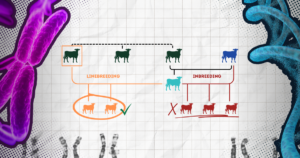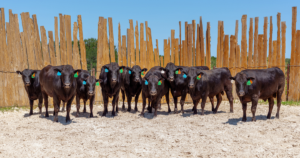Crossbreeding is a popular practice in the cattle industry, intending to improve desirable traits in offspring. Wagyu cattle, originally from Japan, are known for their high-quality meat, marbling, and unique flavor. Crossbreeding Wagyu with other breeds can lead to various benefits, including increased hybrid vigor, better meat quality, disease resistance, higher yields, and lower production costs.
This blog post will explore the benefits of crossbreeding Wagyu with other breeds, the most common breeds used for crossbreeding, and the potential challenges and considerations involved. By the end of this post, readers will have a deeper understanding of the advantages of crossbreeding with Wagyu and how it can help improve the overall quality of cattle in the industry.
What Is Crossbreeding?
Crossbreeding is a breeding method that involves mating individuals from two different breeds or populations. Crossbreeding aims to produce offspring with desirable traits that are not present in either parent breed. This is achieved by combining the genetic traits from each parent breed to produce offspring with increased genetic diversity and hybrid vigor. Crossbreeding is commonly used in the livestock industry to improve various characteristics of animals, such as meat quality, disease resistance, growth rate, and adaptability to different environments. The specific breeding strategy used for crossbreeding depends on the desired outcome, the selected traits, and the parent breeds’ characteristics.
Some of the Best Crossbreeding Techniques For Wagyu cattle
Several crossbreeding techniques can be used for Wagyu cattle to produce offspring with desirable traits. Here are some of the best crossbreeding techniques for Wagyu cattle:
Terminal crossbreeding:
In this technique, Wagyu bulls are crossed with cows of another breed to produce offspring for meat production. The resulting offspring are then sold for slaughter, and the breeding program is discontinued. This technique is commonly used to improve meat quality and yield and introduce hybrid vigor.
Rotational crossbreeding:
Here, Wagyu bulls are mated with cows of another breed, and their female offspring are kept as replacement heifers for breeding. These replacement heifers are then crossed with bulls of a third breed, and the process is repeated in subsequent generations. This technique helps maintain hybrid vigor while producing replacement heifers with desirable traits.
Composite crossbreeding:
This method uses multiple breeds, including Wagyu, to create a new composite breed with specific traits. The new composite breed is then stabilized through selective breeding to ensure the desired traits are consistently passed on to future generations. This technique can be used to produce a new breed that has the desirable traits of multiple breeds.
Backcrossing:
In this technique, the offspring of a Wagyu bull and another breed are mated with Wagyu cows. The resulting offspring have a higher percentage of Wagyu genetics, which can lead to improved meat quality and marbling. This technique can be useful for producing a hybrid animal similar to Wagyu regarding meat quality.
Overall, the choice of crossbreeding technique depends on the specific goals of the breeding program, the resources available, and the characteristics of the parent breeds. By utilizing these crossbreeding techniques, breeders can produce offspring with improved meat quality, disease resistance, and other desirable traits in Wagyu cattle.
Crossbreeding Wagyu With Other Breeds
Crossbreeding Wagyu with other breeds has become increasingly popular in the cattle industry, as it can result in offspring with desirable traits such as improved meat quality, disease resistance, and higher yields. Some of the most common breeds used for crossbreeding with Wagyu include Angus, Hereford, and Holstein.
Angus is often used for crossbreeding to produce Wagyu-Angus hybrids with excellent meat quality and yield. Hereford is another popular choice, as it can improve the fertility and adaptability of the offspring. Holstein is also used for crossbreeding, as it can produce high-yielding dairy cattle with excellent meat quality.
However, it is important to note that the success of crossbreeding with Wagyu depends on various factors such as the breeding strategy, the selection of breeding stock, and proper management of the herd. By carefully considering these factors, breeders can produce offspring with improved traits and enhance the overall quality of the cattle industry.
Wagyu Crossbreeding Benefits With Other Breeds
Crossbreeding Wagyu with other breeds can lead to various benefits, making it a popular breeding practice in the cattle industry. Here are some of the key benefits of crossbreeding Wagyu with other breeds:
Improved Meat Quality:
Wagyu cattle are well known for their high-quality meat, characterized by intense marbling, tenderness, and a unique flavor. Wagyu can pass on its desirable traits to the offspring when crossed with other breeds, resulting in improved meat quality. For example, when crossed with Angus, the offspring exhibit excellent marbling and high-quality beef. This can result in better-tasting meat that is more sought after by consumers, leading to increased profitability for breeders.
Higher Yield:
Crossbreeding can also lead to higher meat and milk production yields. For example, when Holstein cows are crossbred with Wagyu bulls, the resulting offspring produce higher milk yields while producing beef with desirable Wagyu traits. This dual-purpose breeding strategy can result in more efficient use of resources and increased profitability for breeders.
Improved Genetics:
Crossbreeding can increase genetic diversity, leading to improved genetics in the offspring. This can result in stronger, healthier offspring and more resistance to diseases and pests. Additionally, crossbreeding can reduce the likelihood of genetic defects, improving overall herd health.
Augmented Resistance to Diseases and Pests:
Crossbreeding can also result in offspring with improved resistance to diseases and pests. By introducing genetic diversity, offspring can inherit a wider range of immunity traits absent in purebred American Wagyu cattle. This can help reduce the need for antibiotics and other treatments, resulting in healthier cattle and reduced production costs.
Adaptability to Different Environments:
Crossbreeding can also lead to offspring that are better adapted to different environments. By combining the traits of different breeds, breeders can produce offspring better suited to specific climates, terrains, and farming systems. This can result in improved herd health, better performance, and reduced production costs.
Profitability/ Reduced Production Costs:
Crossbreeding can also lead to increased profitability and reduced production costs. By producing offspring with improved meat quality, higher yields, and reduced susceptibility to diseases and pests, breeders can sell their Japanese cattle at higher prices while reducing production costs. Additionally, by using dual-purpose breeding strategies, breeders can use their resources more efficiently, resulting in increased profitability.
It is important to note that the success of crossbred calves depends on various factors, such as the breeding strategy, the selection of breeding stock, and the proper management of the herd. By carefully considering these factors, breeders can produce offspring with improved traits and enhance the overall quality of the cattle industry
Examples of Successful Wagyu Crossbreeding
Crossbreeding Wagyu with other breeds has become a popular breeding practice in the cattle industry. Here are some examples of successful red Wagyu crossbreeding:
Wagyu x Angus:
Crossbreeding Wagyu with Angus cattle has been one of the most popular breeding strategies in the industry. The offspring, known as 100 fullblood Wagyu-Angus hybrids, exhibit excellent meat quality and high yield. The Angus breed is known for its marbling, which results in highly desirable beef when combined with the unique Wagyu marbling. Wagyu-Angus hybrids are also known for their high fertility rates and adaptability to various environments.
Wagyu x Holstein:
Crossbreeding Wagyu with Holstein cows has also become popular in recent years. The Holstein breed is known for its high milk production, and when crossed with Wagyu bulls, the offspring produce high milk yields while maintaining the desirable Wagyu beef traits. These dual-purpose hybrids are highly profitable for breeders, as they can produce milk and beef.
Wagyu x Charolais:
Crossbreeding Wagyu with Charolais has also been successful in producing highly desirable Kobe beef. The Charolais breed is known for its high meat yield, and when crossed with Wagyu, the offspring exhibit excellent marbling and meat quality. The resulting offspring are highly sought after by consumers and command high prices in the market.
Wagyu x Limousin:
Crossbreeding Wagyu with Limousin, another French breed, has also successfully produced highly desirable beef. The Limousin breed is known for its lean Japanese black meat and excellent muscling, which results in a unique and highly desirable American Wagyu beef product when combined with Wagyu marbling.
By carefully selecting breeding stock and implementing proper breeding strategies, breeders can continue to produce highly sought-after Wagyu hybrids that are profitable for the industry.
Potential Challenges In Crossbreeding With Wagyu
While crossbreeding Wagyu with other breeds has many benefits, breeders may face some potential challenges. Here are six potential challenges in crossbreeding with Wagyu:
Maintaining Wagyu Purity:
Maintaining the purity of Wagyu genetics can be a challenge when crossbreeding. Breeders must be careful when selecting crossbreeding partners to preserve the Japanese Wagyu traits and maintain the desired marbled Wagyu beef.
Consistency Of Offspring:
Crossbreeding can result in offspring with varying traits, making maintaining consistent quality across generations challenging. Careful selection of breeding partners and strict breeding protocols can help maintain consistency.
Cost Of Crossbreeding:
Crossbreeding can be a costly process. It requires the purchase of breeding stock and may involve additional expenses for breeding techniques such as artificial insemination of Brown Swiss Cattle.
Health Issues:
Crossbreeding can result in health issues for offspring, such as poor fertility or susceptibility to diseases. Breeders must carefully select healthy breeding partners and monitor offspring closely for carcass traits and health issues.
Market Demand:
While crossbred cows can produce desirable beef breeds like Angus beef products, the market demand for these products can be unpredictable. Breeders must carefully evaluate market trends and demand to ensure that they are producing a product that will be profitable.
Breeding Regulations:
Different countries have different regulations regarding crossbreeding, which can make it challenging for breeders to export their products. Breeders must know these regulations and ensure their breeding practices comply with local laws and regulations.
How To Overcome These Challenges?
There are several strategies that breeders can use to overcome these challenges. Here are a few examples:
Selecting Breeding Partners Carefully:
To maintain the purity of Wagyu genetics and ensure the consistency of offspring, breeders must carefully select breeding partners. This includes evaluating the health and genetics of potential partners to ensure that they have desirable traits and are not carriers of any genetic disorders.
Implementing Strict Breeding Protocols:
Implementing strict breeding protocols can help maintain consistency and quality across generations. This includes using artificial insemination to control the breeding process and carefully monitoring offspring for health or genetic issues.
Investing In Genetic Testing:
Investing in genetic testing can help breeders identify desirable traits and avoid potential health issues in offspring. This includes testing for genetic disorders and using genomic selection to identify offspring with desirable traits.
Monitoring Market Demand:
Breeders must carefully monitor market trends and demand for crossbred offspring to ensure profitability. This includes evaluating consumer preferences and identifying potential niche markets for specific crossbreeds.
Collaborating With Industry Partners:
Collaborating with industry partners, such as other breeders or meat processors, can help breeders overcome cost and market demand challenges. This includes sharing resources and knowledge to optimize breeding and production practices.
frequently asked questions
There is no one-size-fits-all answer to this question, as the best breed to crossbreed with Wagyu will depend on the crossbreeding program’s goals and the offspring’s desired traits. Some successful crossbreeds with Wagyu cattle breed on dairy cross include Angus, Holstein, Charolais, and Limousin.
In most cases, crossbreeding with the Wagyu breed can improve Wagyu beef cattle quality, resulting in more marbling and tenderness with high fatty acid and saturated fat. However, it is important to carefully select breeding partners and monitor offspring for any health or genetic issues to maintain the quality of the Japanese polled or Australian wagyu meat.
Crossbreeding with Wagyu can be more expensive than breeding purebred Wagyu due to the cost of purchasing breeding stock and implementing breeding techniques such as artificial insemination. However, the potential benefits, such as improved meat quality and increased yield, may outweigh the costs.
Yes, crossbreeding with Japanese brown or Wagyu can enhance resistance to diseases and pests due to the increased genetic diversity in the offspring.
Potential challenges in crossbreeding with Wagyu cow include
- maintaining the purity of Wagyu genetics,
- controlling the breeding process,
- identifying desirable traits,
- monitoring for health and genetic issues,
- evaluating market demand
- managing costs.
Breeders can overcome challenges in crossbreeding with Japanese shorthorn Wagyu by carefully selecting breeding partners, implementing strict breeding protocols, investing in genetic testing, monitoring market demand, collaborating with industry partners, and remaining adaptable to changing market trends and regulatory requirements.
There is a growing demand for crossbred Wagyu history, particularly in niche markets that value high-quality specialty meats like the north America Angus cow.
Finally, Here Are Some Considerations Before Starting A Crossbreeding Program
Before starting a crossbreeding program with Wagyu, breeders should consider the following:
- Define the goals of the crossbreeding program and identify the desired traits in the offspring.
- Evaluate the health and genetics of potential breeding partners to ensure they have desirable traits and are not carriers of any genetic disorders.
- Develop a breeding plan that includes strict breeding protocols and monitoring of offspring for any health or genetic issues.
- Determine the demand for crossbred offspring and evaluate consumer preferences to ensure profitability.
- Consider the cost of crossbreeding, including purchasing breeding stock and breeding techniques such as artificial insemination.
- Research local laws and regulations regarding crossbreeding to ensure compliance.




